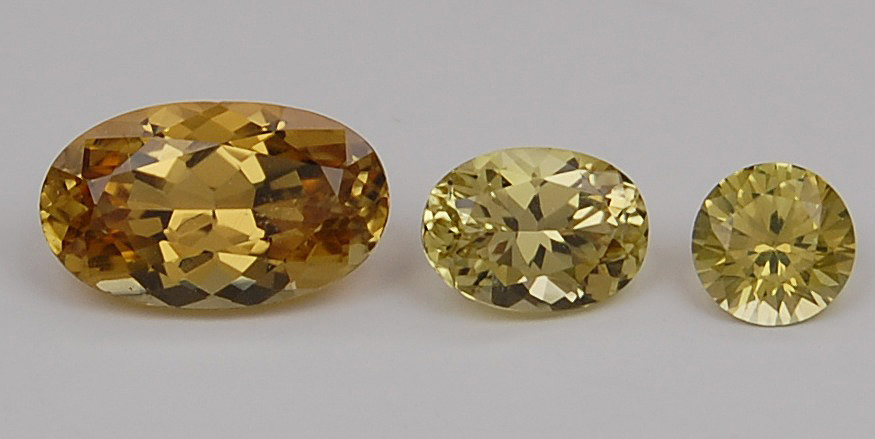
Introduction: Chrysoberyl is a mineral species. It does not have widespread public recognition like its best known variety, alexandrite. In the above photo, from left to right are 2.70 ct oval, 1.11 ct oval and 0.56 ct round, all from Brazil.
Colors: light to medium yellow to yellowish-green, yellow-brown to brown. Some of the yellow-browns and browns can have a medium-dark tone. It is rarely colorless or mint green. The optimum color for cat’s eye chrysoberyl is known as milk and honey. It can be seen in stones of high quality when light strikes the stone obliquely creating a shadow effect within the gem. The side away from the light is a rich brown while the side facing the light is a yellowish-white.
Clarity: Chrysoberyl is of Type I clarity. Gems of this type grow extremely clean in nature and usually have no eye visible inclusions. Typical internal characteristics of chrysoberyl include fingerprint inclusions, mica, calcite, pyrite and silky fibers of sillimanite responsible for cat’s eyes.
Stone Sizes: It is rare for large chrysoberyls to be faceted although one of the largest is a flawless 245 ct oval from Sri Lanka. Typical sizes, available on a regular basis, are up to 10 carats with an occasional stone approaching 20 carats. Mint green chrysoberyls rarely are larger than 3 carats. Cat’s eye chrysoberyl cabochons have been fashioned in large sizes, up to 300 carats, but typical sizes rarely exceed 10 carats.
Localities: Transparent facetable material in the yellow to yellowish-green to brown range is well known from Brazil and Sri Lanka. A mint green variety is very rare but has been found in Tanzania and Sri Lanka. Cat’s eye material is commonly from Brazil, Sri Lanka and India.
Treatments: None.
As a usual course of business, gems of all types are attempted to be treated in some manner to attempt to improve color or clarity with varying degrees of success or failure. Chrysoberyl is no exception. In the 1990’s, some dark brown chrysoberyl cat’s eyes appeared in the market. It was determined that they were irradiated at a nuclear facility to deepen the brown body color. They were also highly radioactive and subsequently removed from the marketplace. Caution should be exercised with any deep brown chrysoberyl cat’s eye and be sent to a qualified lab for testing.
Gemology:
-Refractive Index: 1.746-1.755 (+0.004,-0.006)
-Birefringence: 0.008-0.010
-Optic Character: Doubly refractive, biaxial positive
-Dispersion: 0.015
-Specific Gravity: 3.73 (+/- 0.02)
-Hardness: 8.5
-Toughness: excellent to good
-Chemical Composition: BeAl2O4
-Cause of Color: Iron, Vanadium in mint green colors
-Absorption Spectra: yellow to brown show a strong band at 445 nm. Bands may be visible at 504nm and 486 nm.
-Fluorescence: inert
-Cleavage: indistinct
-Phenomena: Chatoyancy
Name: Chrysoberyl is derived from the Greek, chrysos meaning golden in relation to the color.
Dates: None
Care: The ultrasonic and steam cleaner are usually safe. Warm, soapy water is always safe.
To see available chrysoberyls, click here.
